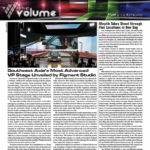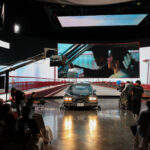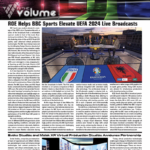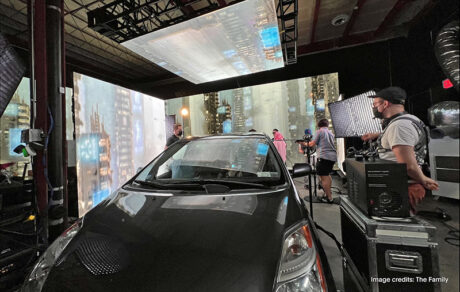
The Family’s Molli and Max in the Future
For the film Molli and Max in the Future, which premiered at 2023’s SXSW Festival, New York production company the Family took advantage of the same technology handpicked by Hollywood’s biggest players to bring sci-fi visuals to the heartfelt rom-com. Brooklyn-based filmmaker Michael Litwak’s ambitions for Molli and Max in the Future drew on a vast array of practical and digital effects.
As writer, as well as director for the project, Litwak had a detailed vision he was excited to realize. The look and feel of the extraterrestrial planets that the main characters explore through this love story are essential to the romantic-comedy storyline, and, with a short period to shoot in, it was crucial to have everything just right from the moment cameras started rolling. Virtual Production Supervisor Steve Dabal knew that the project would fit well with the Family’s technology-driven approach to storytelling. Working with Choreografx Studios, the Family built a modular LED volume that would sit at the heart of the ambitious production – a method that mirrored the approach used by tentpole films and television shows like The Batman and The Mandalorian.
For Dabal, virtual production didn’t just offer opportunities to projects with big studios bankrolling the effects. Using disguise solutions the indie romantic-comedy film was able to run their LED production smoothly and employ blockbuster visual effects. Dabal says, “The story revolves around a relationship over many years, demanding filming in multiple locations to show the passage of time. Now the film didn’t have an Avatar-sized budget, so the challenge was to blend the visually vast sci-fi worlds with the grounded romantic comedy story. Our team was tasked with building a creative and reliable system to film through space and time in as many environments as possible on-set. disguise is an insurance policy ensuring LED productions run smoothly and consistently.”
Though filming took place in a few short weeks, the team had a year to prepare. Multiple scenes feature the characters in moving vehicles, so the team needed to work out how to perfect how their car process looked when the car in question was, in fact, a spaceship. Using disguise’s pre-viz tools, they drew up designs for the sets and car process look, and created storyboards in Unreal Engine. They then tested the scenes out in a small standing stage in Brooklyn prior to shooting.
To keep the footprint of production intimate, the team programmed an iPad playback system that allowed for quick jumping between both 2D media playback content and 3D Unreal Engine scenes powered by disguise RenderStream™. To fit the timeline, Choreografx also set up a remote computer for the cinematographer, Zach Stoltzfus, to log into the Perforce server, allowing him to make changes to scenes up until the last minute. This workflow allowed the team to quickly transcode any video plates to NotchLC and optimise Unreal scenes for playback. “Virtual production is so powerful for immersion,” comments Dabal. “In pre-production we’re able to jump into the world of the movie and collaborate on scenes. And then on-set it sets a tone for the cast and crew to embed themselves in the movie together. Seeing everyone’s eyes light up with each new environment set such a playful tone.”
For the last few years, the stories we hear about virtual production in Hollywood have been connected to big-budget event cinema, and television shows from the likes of Disney and Netflix, but the Family found that it offered an approach to independent filmmaking that opened up new possibilities. Molli and Max in the Future was selected to play as part of the SXSW Festival’s Visions programming, showcasing audacious, risk-taking artists in the new cinema landscape.
“A film like this can be an example for how you can take the genre of romantic comedy and use technology to raise it to an elevated level,” says Dabal. It also shows that, using virtual production, everyone from the biggest studios to visionary independent filmmakers can realize their imaginations’ wildest ideas.
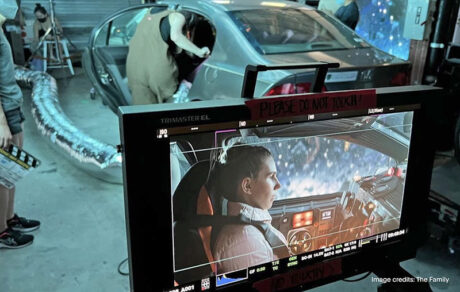
Molli and Max in the Future: Credits
- Director: Michael Lukk Litwak
- Cinematographer: Zach Stoltzfus
- Editor: Joanna Naugle
- Production Designer: Violet Overn
- Virtual Production Supervisor: Steve Dabal
- Virtual Production Producers: Sebastian Clore-Gronenborn and Griffin Yu
- Virtual Production System Engineer: Bryan Dodson
- Virtual Production Screens Producer: Michelle Dodson

BBC’s Better
Looking for opportunities to deliver a more efficient shoot for their crime thriller series Better as well as a way to simplify the car process shots, the BBC turned to Universal Pixels, and their virtual production studio powered by disguise, to shoot 30 internal car scenes in only three days with multiple Directors and DoPs in the mix. With the gritty drama relying heavily on the tense scenes shot inside multiple vehicles, Universal Pixel’s virtual production work ensured that the audience is drawn into the tense action for the duration of the gripping storyline.
Filming on location at Prime Studios in Leeds, Universal Pixels’ In-Camera VFX Specialist Dan Edmonds used the disguise system to provide a seamless virtual production workflow so the BBC team could focus less on making the technical setup work and more on bringing the series’ gripping storyline to life. “After initial testing, we had one week in which we needed to build our set, fit in our three day shoot and strike,” says Edmond. With such a tight schedule to capture all 30 internal car scenes, it was important to make the most of every moment on set. Traditional filming methods would have required balancing a wide range of logistics to ensure a relatively easy shoot. With Universal Pixel’s LED volume powered by disguise, these difficult factors were immediately eliminated. Building a custom LED set using ROE Visual’s Black Diamond screens, the team were able to place their vehicle in front of any virtual background they needed. Powered by two disguise gx 2c media servers, the visuals were played back to perfection in an easy-to-control setup.
For Edmonds, a major benefit for the production was the pre-viz tools offered by disguise’s workflow. Each shot could be planned out in advance, meaning that no time was wasted in the short shooting window. disguise’s virtual production technology was also key to the shoot’s success, enabling the team to playback the driving plates with 360° of freedom, which, in conjunction with custom-made LUTs (look-up tables), allowed for the team to deliver scenes that fit in naturally with the wider production.
The ability to control driving plate continuity went beyond grading, with the production able to fully dictate the video plate content of their scenes, and work flexibly to ensure that everything lined up perfectly in post. This was important, with multiple directors overseeing the scenes being shot during the short run of filming in the volume. “disguise helped the team on-site to simplify the workflow,” explains Edmonds. “This allowed flexibility for the production to preview selects and make sure they fitted the scene being shot.” The team were able to take a wide range of scenes set at different times of day, with different weather conditions, and in different locations, and film them all on the same set. “The production crew had very little previous experience with this process,” notes Edmonds. “So, it was great to see how pleased everyone was with the speed of the shoot and the quality of the results it gave them.” When Better hit the air on the BBC in February 2023, the car scenes fit seamlessly into the show.
